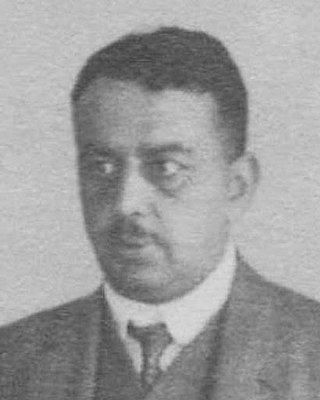
Béla Bollobás FRS is a Hungarian-born British mathematician who has worked in various areas of mathematics, including functional analysis, combinatorics, graph theory, and percolation. He was strongly influenced by Paul Erdős since the age of 14.

Dénes Kőnig was a Hungarian mathematician of Hungarian Jewish heritage who worked in and wrote the first textbook on the field of graph theory.
In the mathematical discipline of graph theory, a graph labeling is the assignment of labels, traditionally represented by integers, to edges and/or vertices of a graph.

In mathematics, and more specifically in graph theory, a multigraph is a graph which is permitted to have multiple edges, that is, edges that have the same end nodes. Thus two vertices may be connected by more than one edge.

Mehdi Behzad is an Iranian mathematician specializing in graph theory. He introduced his total coloring theory during his Ph.D. studies in 1965. Despite the active work during the last 50 years this conjecture remains as challenging as it is open. In fact, Behzad's conjecture now belongs to mathematics’ classic open problems.

Ronald James Gould is an American mathematician specializing in combinatorics and graph theory. He is a Goodrich C. White professor emeritus in the Emory University Department of Mathematics.

In graph theory, a T-Coloring of a graph , given the set T of nonnegative integers containing 0, is a function that maps each vertex to a positive integer (color) such that if u and w are adjacent then . In simple words, the absolute value of the difference between two colors of adjacent vertices must not belong to fixed set T. The concept was introduced by William K. Hale. If T = {0} it reduces to common vertex coloring.
Michael David Plummer is a retired mathematics professor from Vanderbilt University. His field of work is in graph theory in which he has produced over a hundred papers and publications. He has also spoken at over a hundred and fifty guest lectures around the world.
In graph theory, a part of mathematics, a k-partite graph is a graph whose vertices are partitioned into k different independent sets. Equivalently, it is a graph that can be colored with k colors, so that no two endpoints of an edge have the same color. When k = 2 these are the bipartite graphs, and when k = 3 they are called the tripartite graphs.
In graph theory, a highly irregular graph is a graph in which, for every vertex, all neighbors of that vertex have distinct degrees.
In graph theory, a L(h, k)-labelling, L(h, k)-coloring or sometimes L(p, q)-coloring is a (proper) vertex coloring in which every pair of adjacent vertices has color numbers that differ by at least h, and any nodes connected by a 2 length path have their colors differ by at least k. The parameters, h and k are understood to be non-negative integers.

L(2, 1)-coloring is a particular case of L(h, k)-coloring. In an L(2, 1)-coloring of a graph, G, the vertices of G are assigned color numbers in such a way that adjacent vertices get labels that differ by at least two, and the vertices that are at a distance of two from each other get labels that differ by at least one.
Hamiltonian coloring, named after William Rowan Hamilton, is a type of graph coloring. Hamiltonian coloring uses a concept called detour distance between two vertices of the graph. It has many applications in different areas of science and technology.
Ortrud R. Oellermann is a South African mathematician specializing in graph theory. She is a professor of mathematics at the University of Winnipeg.
Ewa Maria Kubicka is a Polish mathematician interested in graph theory and actuarial science. She is known for introducing the concept of the chromatic sum of a graph, the minimum possible sum when the vertices are labeled by natural numbers with no two adjacent vertices having equal labels.
Ermelinda DeLaViña is an American mathematician specializing in graph theory. She is a professor in the Computer and Mathematical Sciences Department of the University of Houston–Downtown, where she is also Associate Dean of the College of Science and Technology.
Ping Zhang is a mathematician specializing in graph theory. She is a professor of mathematics at Western Michigan University and the author of multiple textbooks on graph theory and mathematical proof.
Margit Voigt is a German mathematician specializing in graph theory and graph coloring. She is a professor of operations research at the University of Applied Sciences Dresden.
Ralucca Michelle Gera is an American mathematician specializing in graph theory, including graph coloring, dominating sets, and spectral graph theory. Her interests also include personalized learning in mathematics education. She is a professor of mathematics at the Naval Postgraduate School.
Stephen T. Hedetniemi is an American mathematician and computer scientist specializing in graph theory. He is professor emeritus of computer science at Clemson University.







